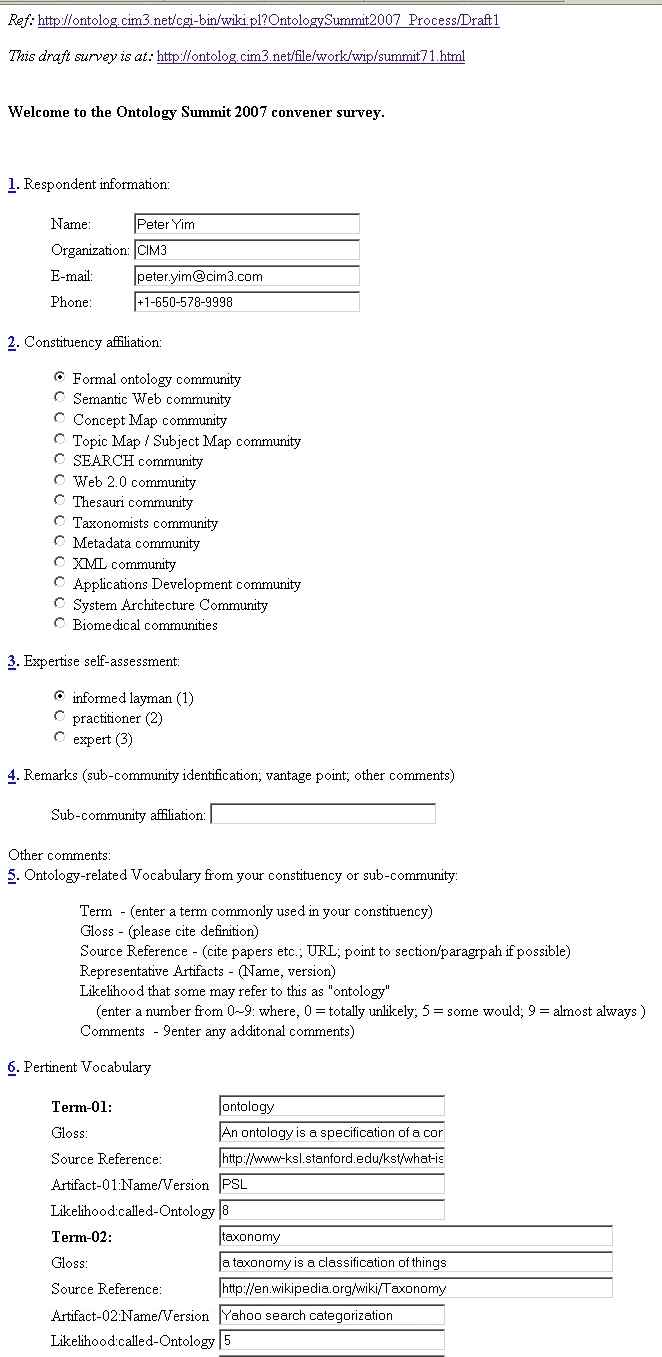Ontolog Forum
Ontology Summit 2007: OntologySummit2007_Process proposal-1 (draft)
First proposed: Peter P. Yim / 2007.02.14
A 5-Step Process
- Convener Grouping: Summit participants ("conveners") are dispersed into 'teams' (constituencies[1]), each representing major communities within the broader ontology community space
- we can use a survey[2] to help identify which team an individual participant is affiliated with
- an analysis of the survey results can also provide clues as to whether we have balanced representation in different constituencies, and if not, remedial 'recruitment' actions may be taken
- a participant can choose to be in more than one team
- each team is encourage to elect a champion to help coordinate and track progress (this is optional, though)
- Understanding the Community Vocabulary: Each constituency will:
- identify the context (vantage point) from which their inputs are derived; there may be needs to create further subdivisions. (For example: if "Biomedical informatics practitioners" is one such constituency, and it turns out that that the "bio-informaticists" and the medical-informaticists" don't share the same vocabularies, then they may want to subdivide and collect inputs for each of these sub-teams.
- (each team) or each sub-team will come up with the gloss for what do they mean when they use the term "ontology"
- identify other ontology-related terms that is in their constituency's common vocabulary,
- and come up with the gloss for each of these terms
- also assess the Likelihood that someone may refer to each of these terms as "ontology"
- ( 0 = totally unlikely; 5 = some would; 9 = almost always )
- identify conspicuous ontology (or ontology-like) artifacts[3] within their constituency
- the above is discovered through dialog over the [ontology-summit] discussion forum, aided (where necessary) by the survey[2] and continuously summarized and synthesized and posted to the wiki to keep all participants in sync.
- each constituency will complete and vet their glossary and list of ontology (or ontology-like) artifacts
- Constructing a categorization / typology framework[4]
- this is done between all coneveners
- and done in parallel with the virtual discourse described in 2. above
- Categorize
- place terms and artifacts into the above categorization framework (by each constituency)
- reach shared understanding on typology
- Authoring the Communique
- draft
- review, modify, enhance
- adopt (with list of endorsers)
- release / publish
Resource & References
[1] different constituencies - see under here
[2] survey - sample of a completed survey that may augment the above process - see: draft survey
[3] ontology (or ontology-like) artifacts for each constituency - see [ http://ontolog.cim3.net/cgi-bin/wiki.pl?OntologySummit2007_Process/Draft1#nidU6N sample below]
-
- we need both name and version (as different versions of the artifact with the same name may be placed differently in the categorization framework, and hence their typology may differ
[4] categorization / typology framework - see: OntologySummit2007_FrameworksForConsideration
Survey questions (Draft-1)
1. Respondent information - (name, organization, e-mail, phone)
2a. Constituency affiliation
[ ] Formal ontologists community
[ ] Semantic Web communities
[ ] Concept Map community
[ ] Topic Map community
[ ] SEARCH communities
[ ] Web 2.0 community
[ ] Thesauri community
[ ] Taxonomists community
[ ] Metadata communities
[ ] XML community
[ ] Applications Development community
[ ] System Architecture Communities
[ ] Biomedical communities
2b. Expertise self-assessment
- 1 = informed layman
- 2 = practitioner
- 3 = expert
3a. Remarks (sub-community identification; vantage point; other comments)
3b. Ontology-related Vocabulary from your community
- Term
- Gloss
- Source Reference - (cite papers etc.; URL; point to section/paragrpah if possible)
- Representative Artifact - (Name, version)
- Likelihood that some may refer to this as "ontology"
- (enter a number from 0~9: where, 0 = totally unlikely; 5 = some would; 9 = almost always )
- Comments
(repeat, say, 8 times, allowing multiple item entries on the form)
Remarks: if a participant chooses to be in more than one team (represented in more than one constituency), he/she will complete and return more than one survey.
See a prototype of this form at: http://ontolog.cim3.net/file/work/wip/summit71.html
Sample of a completed survey (on the prototype form) - (Draft-1)


